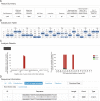Web-based design and analysis tools for CRISPR base editing
- PMID: 30587106
- PMCID: PMC6307267
- DOI: 10.1186/s12859-018-2585-4
Web-based design and analysis tools for CRISPR base editing
Abstract
Background: As a result of its simplicity and high efficiency, the CRISPR-Cas system has been widely used as a genome editing tool. Recently, CRISPR base editors, which consist of deactivated Cas9 (dCas9) or Cas9 nickase (nCas9) linked with a cytidine or a guanine deaminase, have been developed. Base editing tools will be very useful for gene correction because they can produce highly specific DNA substitutions without the introduction of any donor DNA, but dedicated web-based tools to facilitate the use of such tools have not yet been developed.
Results: We present two web tools for base editors, named BE-Designer and BE-Analyzer. BE-Designer provides all possible base editor target sequences in a given input DNA sequence with useful information including potential off-target sites. BE-Analyzer, a tool for assessing base editing outcomes from next generation sequencing (NGS) data, provides information about mutations in a table and interactive graphs. Furthermore, because the tool runs client-side, large amounts of targeted deep sequencing data (< 1 GB) do not need to be uploaded to a server, substantially reducing running time and increasing data security. BE-Designer and BE-Analyzer can be freely accessed at http://www.rgenome.net/be-designer/ and http://www.rgenome.net/be-analyzer /, respectively.
Conclusion: We develop two useful web tools to design target sequence (BE-Designer) and to analyze NGS data from experimental results (BE-Analyzer) for CRISPR base editors.
Keywords: Base editing; CRISPR; Genome editing; NGS analysis; Web-based tool.
Conflict of interest statement
Ethics approval and consent to participate
Not applicable.
Consent for publication
Not applicable.
Competing interests
The authors declare that they have no competing interests.
Publisher’s Note
Springer Nature remains neutral with regard to jurisdictional claims in published maps and institutional affiliations.
Figures



References
-
- Doudna JA, Charpentier E. The new frontier of genome engineering with CRISPR-Cas9. Science. 2014;346:–1258096. - PubMed
MeSH terms
LinkOut - more resources
Full Text Sources
Other Literature Sources
Research Materials

